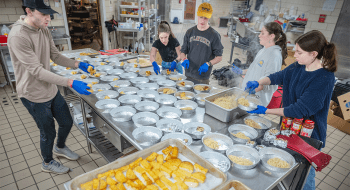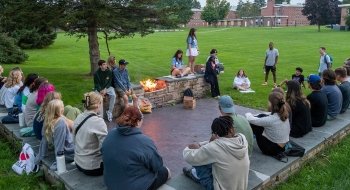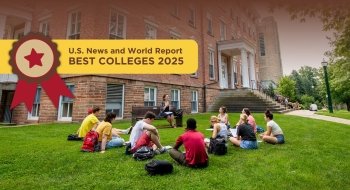
Birthday cake from New Orleans and 55,000 other deliveries that illustrate how life has changed for college students in the 21st century.
“We get some weird stuff,” says Warren Harman, senior clerk at St. Lawrence’s Student Mail Center. “We even got a birthday cake for somebody from a special bakery in New Orleans.”
Harman, now in his third year managing the sending and receiving of mail for the 2,400 students at St. Lawrence, has a unique lens on the 21st-century college student and exactly how things have changed since the advent of online shopping.
Besides the more predictable deliveries of textbooks, school supplies, and care packages from home, Harman proceeds to list a few of the more unusual deliveries, everything from tires, sofas, 70-inch flat-screen televisions, and cell phones to tropical fish, crickets, plants, and workout equipment. Harman continues, “There’s even a hunting group on campus, and for a while, we had flocks and flocks of artificial duck decoys…” and, “There was one student organization that ordered eight regulation-size ping-pong tables for a tournament.”
During the first six weeks of each semester, the Student Mail Center will process a staggering 13,000+ packages. Over the course of the academic year, the number of packages received will exceed 55,000. That is not including packages related to University business or shipments received by the Brewer Bookstore.

“Two weeks before classes even started,” says Harman, “we had 23 giant packages here big enough to put your little brother in.” Based on the size and the sender, Harman knows those boxes are mostly blankets, linens, pillows, and towels for first-year or international students who scheduled their room kits to arrive prior to their move in.
“All of the stuff that used to come up in the back of mom and dad’s car now goes through our window,” says Harman. His colleagues at the other three local colleges agree that people would rather ship it than carry it. “And that’s kind of the world we live in,” says Harman.
Refrigerators are now a necessity for mail centers as more and more students subscribe to meal services such as Blue Apron or do their grocery shopping through online services. Deliveries include steaks, lobster, cheese, energy drinks, and even wine of the month club deliveries for the over-21 crowd. Students do not even have to walk down to the local pharmacy for a toothbrush or cold medicine, according to Harman. “If a parent hears their child is sick at school, they might want to send them some chicken noodle soup and maybe some NyQuil, or who knows what,” he says.
With a master’s degree in industrial psychology, Harman can’t help but wonder about the behaviors and motivation of sending and receiving all of this stuff. His work forces him to not only think about the process control of intake and output, but the emotional relationships of the people behind the packages.
“Somebody bought one of those bicycles built for two,” says Harman, “just in time to leave school. I don’t know why they did that.” And the birthday cake? That one remains a puzzle. “They never picked it up,” says Harman. “It ended up going bad, unfortunately, but it smelled really good for the first week.”
“During certain times of the year it’s like a choreographed ballroom waltz,” says Olga Grant, manager of Office Services. “We had at least 600 costumes delivered before Halloween weekend and students lining up at the last minute at 4 p.m. on Friday afternoon desperate to pick them up.” For Valentine’s Day, there are flower deliveries, chocolates, cards and gifts. “I just delivered a case of seaweed,” says Grant, who marvels at the variety of goods that come through the loading docks of the Sullivan Student Center.
The majority of 21st-century mail no longer resembles the sealed hand-written correspondences and traditional packages. More and more deliveries are fragile or perishable or require special packaging or a timely pickup. Along with the waste of expired foods, the sheer volume of shipping materials creates an enormous recycling challenge, especially for a campus trying to reduce its carbon footprint.
Waste Not
A recycling area was originally set up in coordination with the University's sustainability coordinator to give students access to packing materials for free. According to Grant, the cardboard recycling volume and costs associated with disposal were increasing quickly as package volumes increased.
During the last three years, Grant and Harman have worked to establish partnerships to address the problem. Recent graduate Hogan Dwyer ’19, a student leader with the Environmental Action Organization (EAO), was one of those partners.
“Hogan was concerned about the recycling in the student mail room and asked if there is anything students can do to maximize the reuse efforts for boxes, bubble wrap, air bags, etc.,” says Harman. “The club's efforts have been helpful and have increased the re-use of packing materials, specifically the plastic packaging, to return textbooks and other shipped items.” Think about it: 55,000 packages. That is a lot of bubble wrap.
To help manage the madness, Harman employs 14 to 16 student workers. Each goes through training to be able to handle and process United States Postal Service, UPS, and FedEx shipping and receiving. All of the scanning, documentation, and daily logs are stored on the cloud off-site so that the team does not have to worry about maintaining a local database.
When hiring his student workers, Harman says, “I look for people with a motor. They have to have something that drives them.” Critical thinking skills are necessary, he explains, because the entire operation relies on accuracy and the students need to notice when things are out of place or labeled incorrectly.
“Right now, we’ve got a great team,” says Harman who prepares new student workers by putting them through a mail room boot camp which, he explains, “indoctrinates them into the insanity.”
“Jeddy can see a mistake from a mile away,” says Harman, introducing Jedidah “Jeddy” Ngarah ’20, a senior from Kenya, who has been working in the mail center for the past four years and is one of his most experienced employees.
“She is very aware of things that are out of sorts,” says Harman, “and very good at seeing patterns in terms of what is off in the system.”
“I think ordering bikes is just crazy,” says Ngarah, commenting about some of the more outrageous deliveries they have processed recently. “People just order big stuff,” she says as she remembers an enormous rug that came in the length of the mailroom hallway, not even close to being able to fit in a dorm room.
“I think there’s a story in every package,” Harman says. “We have such a diverse population. It’s really interesting just to see where things are coming from.” He points to a giant box and guesses it might be a comforter. “It makes you think about how students are coming from so far away and they’ve somehow managed to make this home.”



